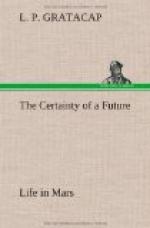In 1889, Prof. Schiaparelli reviewed what had been observed upon the surface of the planet in a continued article in Himmel und Erde, a popular astronomical journal published by the Gesellschaft Urania and edited by Dr. Meyer.
Some remarkable photographs taken by Mr. Wilson in 1890 were commented on by Prof. W.H. Pickering in the “Sidereal Messenger.” They showed the seasonal variations in the polar white blotches.
In 1889 there reached us from Chatto and Windus of London a most entertaining book by Hugh MacColl, entitled “Mr. Stranger’s Sealed Packet.” It was a work of fancy, ingeniously constructed upon scientific principles. It described a hypothetical machine, a flying machine, which was made up of a substance more than half of whose mass had been converted into repelling particles. Such a fabric would leave the earth, pass the limits of its attraction with an accelerating velocity and move through space. In such a way Mr. Stranger reached Mars. He found it inhabited by a people—the Marticoli—happy in a state of socialism, and with abundance of food manufactured from the elements, oxygen, hydrogen, carbon and nitrogen, with electric lights, phonetic speech, but without gunpowder or telescopes.
Its inhabitants had been derived from the earth by a most delightful scientific fabrication. A sun and its satellites in its course around some other center draws the earth and Mars so together that on some parts of the earth’s surface the attraction of Mars would overcome that of the earth and gently suck up to itself inhabitants from the earth, who would not suffer death from loss of air, as the atmosphere of both bodies would be mingled.
These observations and this last scientific myth have some interest in view of the actual knowledge now vouchsafed to the world through my father’s messages. I have very briefly reviewed them.
My father’s premonitions were fully realized. He grew sensibly weaker as the months of 1891 passed. His mind became eager with the cherished expectation which grew day by day into a sort of a mild possession. It seemed to me that there was a moderate aberration involved in his deeply seated convictions, and when sometimes I saw him walking past the windows on the plateau with his head thrown back, his arms outstretched as if he were inviting the stars to take him and his murmuring voice, repeating some snatches of song, I felt awed and frightened.
My father was stricken with paralysis on September 21, 1892, became speechless the following day, but for a day thereafter wrote on a pad his last directions. Some of these were quite personal, and need not be detailed here. It was indeed pathetic to see his strenuous and repeated efforts to assure me that he remembered all the parts of the telegraphic apparatus, and his smile of saddened self-depreciation when he hesitated over some detail. At last he sank into a torpor with the usual stertorous breathing, flushed face and gradually chilled extremities. His last words were scrawled almost illegibly by his failing hand—“Remember, watch, wait, I will send the messages.”




